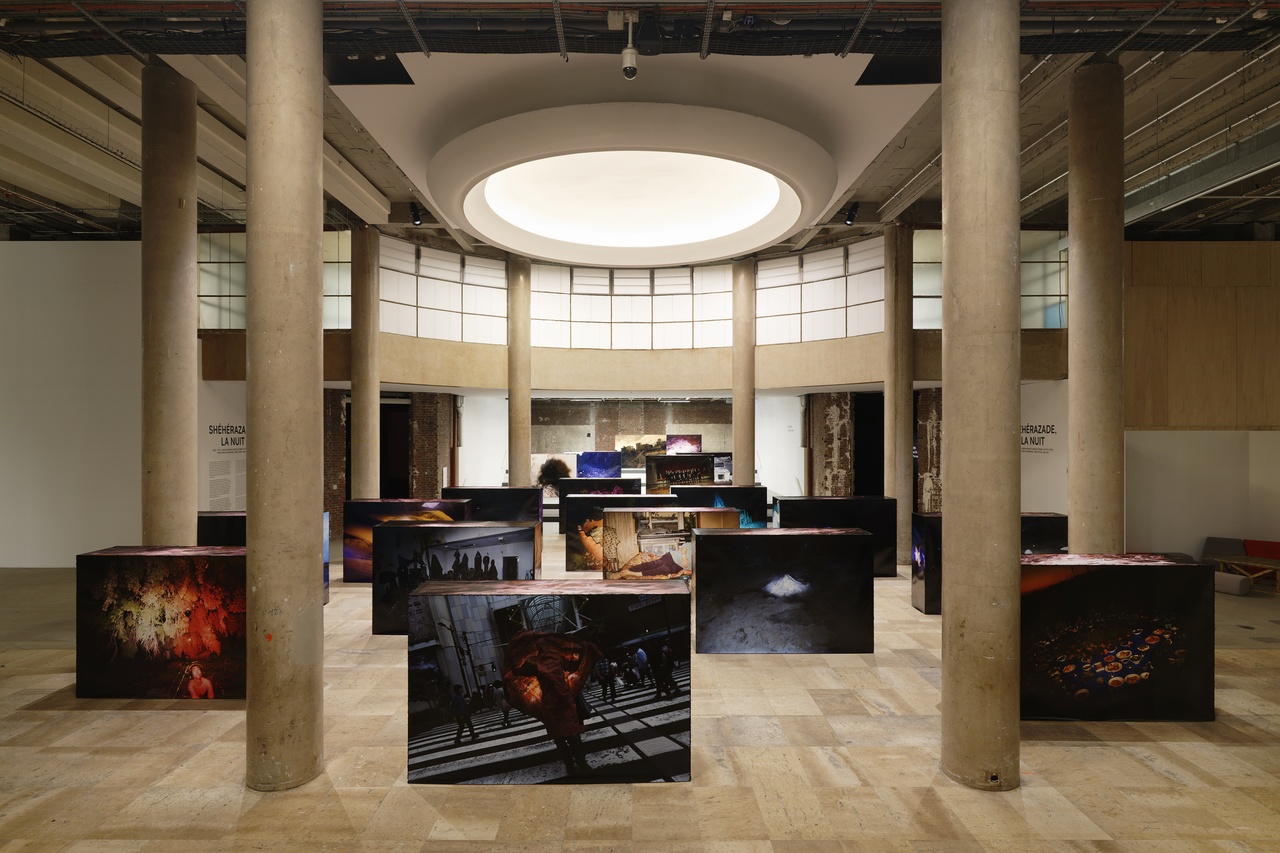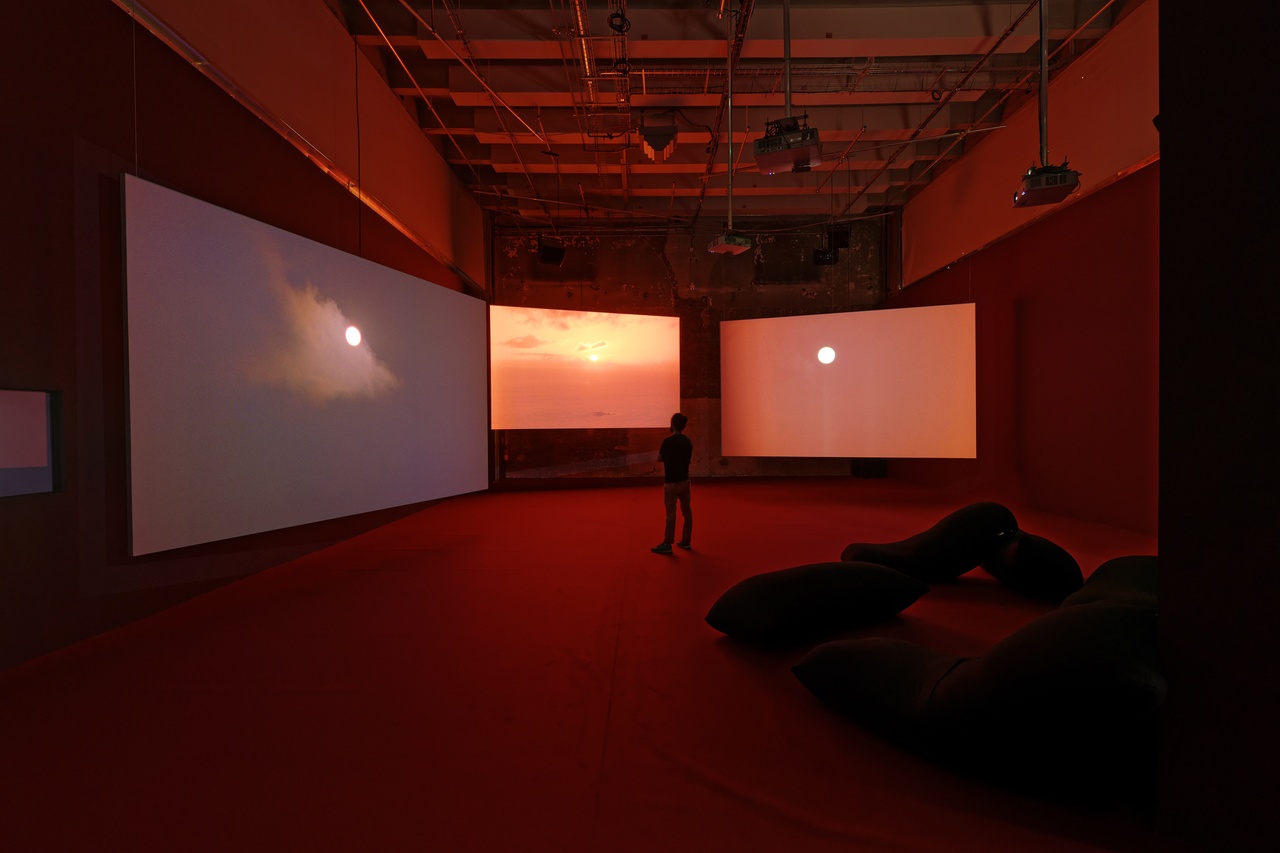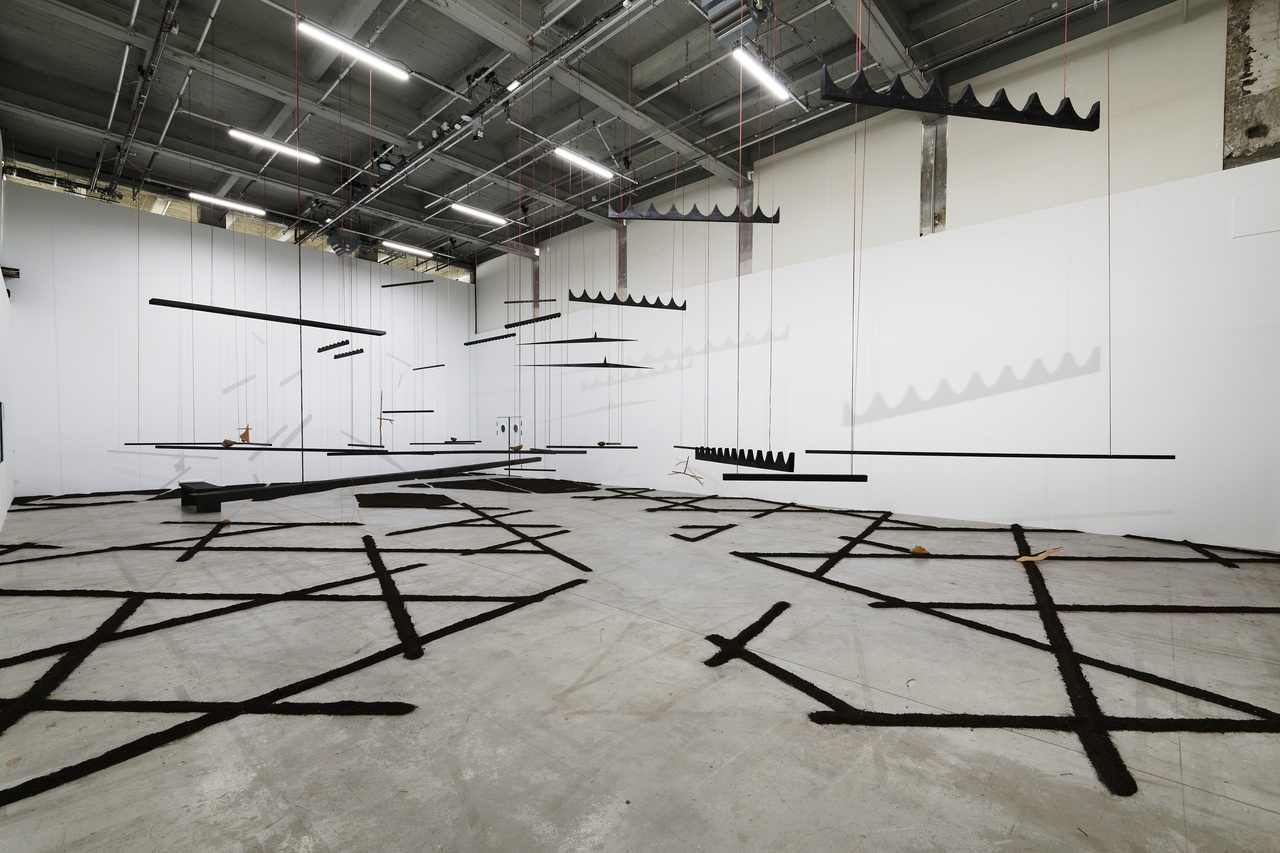A JOURNEY TO THE END OF THE “NIGHTS” Line Ajan on “Shéhérazade, la nuit” at Palais de Tokyo, Paris

Lieko Shiga, “Human Spring,” 2019
The exoticizing imaginary summoned by the mere mention of the One Thousand and One Nights and its astute heroine Scheherazade is by now well-known, if not well-worn. Dating back to the Islamic Golden Age, this collection of Persian folktales circulated widely, first in its Arabic adaptation Alf Layla wa Layla (ألف ليلة وليلة), and later in its French translation by Antoine Galland, published between 1704 and 1717, and its English adaptation by Richard Francis Burton in 1885 to 1888. Its reception in the West was tinted with the orientalist approach of the translators and their colonialist mindset, thus triggering clichés on the decadent lasciviousness of “the Orient” – a nebulous construction associated “with the escapism of sexual fantasy” as Edward Said put it. [1] While the versions of the Nights vary in content, their narrative structure remains a constant: an early adept of the cliff-hanger, Scheherazade narrated her way out of being killed by her husband Shahryar, a gruesome ruler who had serially been marrying women and murdering them the next day in paranoid retaliation for his first wife cheating on him. Scheherazade tricks him by perpetually postponing each enthralling tale’s resolution: storytelling, then, was for her a survival strategy and a tool for resisting an abusive power.
Disregarding the loaded imaginary attached to the source literature, the exhibition “Shéhérazade, la nuit” (Scheherazade, at night) at Palais de Tokyo takes instead the protagonist’ strategic use of narration against hegemony as its starting point, utilizing it as the thread linking the works of Minia Biabiany, Miguel Gomes, Ho Tzu Nyen, Pedro Neves Marques, Lieko Shiga, and Ana Vaz – a line-up of mainly non-Western artists that makes the title’s ambiguity provocative. Composed of six capsule solo presentations that together amount to one group exhibition, “Shéhérazade, la nuit” unfolds like an experiential journey marked by a measured rhythm. Indeed, the exhibition asks visitors to take their time, not only because of its curatorial stance of interlocking shows (which entails diving into six different practices), but also because it mainly features moving-image works – a choice alluded to in the title, as projections are seen best in the dark. A time-based medium particularly adapted for the albeit broad theme of narration, video is specifically relevant for Palais de Tokyo’s history, which is marked by the 1986 creation of the Palais de l’image that gathered the Cinémathèque française and the FÉMIS [2] in the building’s west wing. Versed in the Parisian art center’s chronology, curator Yoann Gourmel leaned into the increasingly blurry boundary between video art and cinema to craft this expansive, [3] but at times digressional, meditation on how a situated approach to narration impacts moving image and vice-versa.

Ana Vaz, “The voyage out,” 2016–2022
The exhibition deploys a wide variety of filmic and video apparatuses, deftly shifting from multiple-channel installations displayed in black boxes with the works of Ho Tzu Nyen, Ana Vaz, and Pedro Neves Marques to film projections in an exhibition space arranged to look like a movie theater for the work of Miguel Gomes. However, the show begins with a photographic installation rather than a moving-image work, which accordingly fails to set the tone for the curatorial statement. Lieko Shiga’s murky Human Spring (2019) depicts the psychological impacts of Japan’s 2011 triple disaster – the Tōhoku earthquake and tsunami that led to the nuclear meltdown at the Fukushima Daiichi nuclear power plant – on the inhabitants of the town of Kitakama mainly during nighttime; these enlarged and dark photos printed on rectangular plinths awkwardly hint at the narrative potential of photographic documentation. Indeed, the link to narration is not as straightforward in Human Spring as it is in the other exhibited works. The installation does, nevertheless, introduce an important throughline of the show: an artist’s attachment to specific geographies, and how these places influence the work they create. In effect, Shiga herself was in Kitakama when the earthquake broke.
This territorial anchoring is most acutely explored within the impressive presentation of works by Singaporean artist Ho Tzu Nyen, whose focus is regional rather than national, thus offering a more nuanced understanding of official narratives. Taking over most of the right-side pavilion flanking the hall where Shiga’s work stands are three immersive installations by Ho, including the compelling The Critical Dictionary of Southeast Asia (CDOSEA) (2012–ongoing). This algorithmically generated video is structured around a succession of Shutterstock footage depicting elements supposedly representative of Southeast Asia – a territory that has been described as “the idea of a region” [4] by curator David Teh, who has written extensively on both Ho’s work and on Southeast Asia’s artistic landscape more broadly. Sorted in alphabetical order, these emblems are simultaneously enumerated by an eerie voice-over – “A for archipelagos,” “M for mandala,” “T for tiger” – which subversively points to the constructed parts of this regional history. As a shape-shifting symbol, the tiger reappears in One or Several Tigers (2017) – a more baroquely animated video by Ho. This dizzying work fully exploits its two-channel apparatus and leads the viewer to constantly switch viewpoints, thus emphasizing the necessity for multiple perspectives to untangle Singapore’s foundational myths, including one featuring the (were)tiger. The legend that gave Singapore its name (which literally translates to “Lion City” from Sanskrit), revolves around Srivijayan prince Sang Nila Utama, who had allegedly spotted a lion upon his arrival to the island-country sometime in the 13th century and regarded the sighting as a good omen. Historians and scientists, however, have stressed that the animal was likely a Malayan tiger rather than a lion. Surely the highlight of “Shéhérazade, la nuit,” Ho’s installations evidence an equal mastery of the medium and the theme at hand, and so offer the most articulate expression of Gourmel’s curatorial intent.

Minia Biabiany, “nuit,” 2022
This presentation exemplifies how the curator homes in on the range of processes and materialities that characterize moving images. The narrative registers mobilized by the artists are equally varied, further resisting rigid forms. This is particularly palpable in Ana Vaz’s languid and captivating The Voyage Out (2016–22), a three-channel installation that unfolds over four-and-a-half hours, and as such stands at the edge of cinematic experience. Displayed in a large room in the left wing of Palais de Tokyo, this digitized 16mm film is resolutely meditative, and the visitor who enters the space is bound to linger for at least a portion of the film. An epistolary dialogue between the artist and another person, depicted through transcriptions of their conversation, slowly reveals that the film revolves around the impact of the Fukushima disaster and how survivors speak about it. Focusing largely on the perspective of Yoko Hayasuke, a witness of the catastrophe, the email exchange is as much a formal as a conceptual strategy: here, narration enables both the subject and the process of the work to unravel. Hayasuke’s testimony coexists with other perspectives through a series of portraits, images of fireworks, equally fiery sunsets, and oscillating red backgrounds that alternate on the three suspended screens and complement the room’s crimson carpet. The show’s scenography is generally remarkable, with subtle moments that create graceful dialogues between the works. While watching Vaz’s film, one can peer into the rooms dedicated to Neves Marques through a small, ribboned window – a feature that recalls the screen through which Scheherazade would spy on Shahryar.
The sci-fi-infused fictions of Neves Marques are surely the ones most marked by literary influence in the exhibition, including that of Ursula K. Le Guin and Octavia Butler. More importantly, their videos introduce an ecological breadth to the territorial anchoring that is at the core of the exhibition, as evidenced by Semente Exterminadora (Exterminator Seed, 2017). The work centers a conversation between an oil-rig worker and Ywy – a woman who, we soon discover, is not human – following the contamination of the Brazilian coast by an oil spill. The toxic impact of colonial extractivism on humans and land alike is suggested in Minia Biabiany’s film-poem titled the length of my gaze at night (2022). Here, the ocean appears as the receptacle of intergenerational trauma present in Biabiany’s native Guadeloupe, formerly colonized by the French republic and today commonly referred to as “overseas France.” An equally delicate installation sprawls on the floor, with various lines of soil drawing a geometrical pattern that recalls Caribbean creel weaving. Set in the only white-walled and lit space of the show, Biabiany’s presentation induces a liberatory feeling. Ending the exhibition with an almost telluric understanding of territorial anchoring through the presence of actual compost, Biabiany’s practice additionally offers an embodied approach to narratives of belonging.
This graceful finale of “Shéhérazade, la nuit” acts like a double-edged sword. On the one hand, Biabiany’s work highlights the exhibition’s very pitfall: resolutely embedded in the artist’s native Guadeloupe, it points to the potency of lived experience when tackling colonialism and coloniality. The loaded connotation of the exhibition’s title, left unaddressed, appears even more blatant at the end of the show: the risk of adopting a supposedly neutral curatorial position contrasts with the validity of artists defining themselves by place. On the other hand, Biabiany’s work seems like the most metaphorically and formally coherent ending of a journey in the depths of the night and the darkness of screening rooms.
“Shéhérazade, la nuit,” Palais de Tokyo, Paris, October 19, 2022–January 8, 2023.
Line Ajan is a curator and art historian living between Luxembourg and Paris. She is currently a Curatorial Fellow at Mudam Luxembourg, where her research revolves around video and new media art, focusing on artists engaging music and humor as aesthetic strategies of political resistance.
Image credits: Palais de Tokyo, Paris, photos Aurélien Mole
Notes
| [1] | Edward W. Said, Orientalism (New York: Vintage Books, 1979), 190. |
| [2] | La FÉMIS, or La Fémis, short for Fondation Européenne pour les Métiers de l'Image et du Son, is a prestigious film school based in Paris. |
| [3] | In addition to the ten or so moving-image works included in “Shéhérazade, la nuit,” the curator conceived a parallel public program titled “1002ème nuit” (1002nd night), which consisted of screenings and talks with additional artists such as Phoenix Atala and Rayane Mcirdi. |
| [4] | David Teh, “Under One or Several Flags,” in Ho Tzu Nyen: G for Gong, ed. Edit Molnár and Marcel Schwierin (Oldenburg: Edith-Russ Haus; Berlin: Sternberg, 2019), 36. Italics in original. |
